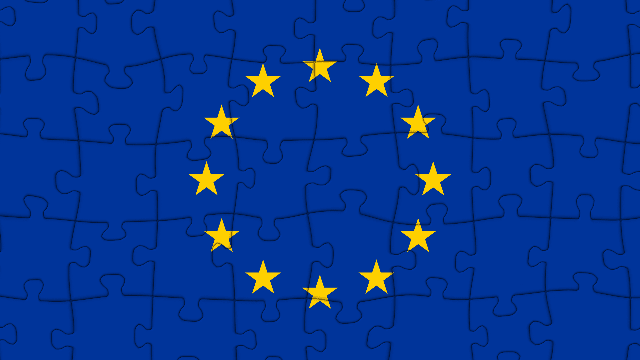Reflets Magazine #156 | Geopolitics: EU Forced to Reshuffle its Cards
From Russian expansionism and US disengagement to Chinese competition and more. In Reflets Mag #156, six ESSEC experts present an overview of the major geopolitical challenges facing Europe.
Aurélien Colson (E98): “The EU faces a combination of threats”
Reflets Mag: What Threats Does the EU Face?
A. Colson: On the one hand, Russia is waging a high-intensity war against one of our neighbours, Ukraine, along with a hybrid war that is directly affecting our interests: sabotage of undersea energy or telecommunication cables, jamming of GPS equipment near Baltic airports, cyber attacks against our hospitals, interference with elections, and so on. On the other hand, the new American administration is undermining the Euro-Atlantic alliance. At the same time, anti-European parties, both far-right and far-left, have never been so powerful, supported (covertly) by Russia and (openly) by the Trumpists.
RM: What are the scenarios for the future?
A. Colson: Everything will depend on the lucidity of our leaders, their courage and their ability to make decisions as a body of 27 nations. Recent history offers some hope: the Member States managed to negotiate a massive emergency response plan to the pandemic, followed by a series of sanctions against Russia. The same determination is needed to build a conventional deterrent capable of keeping Russia at bay despite the US withdrawal, and to regain economic sovereignty.
RM: What about enlarging the Union? Does more unity provide more strength?
A. Colson: No fewer than 10 countries are candidates for EU membership, and Armenia has just taken a step in this direction. However, these demands offend both federalists (who believe that each enlargement is to the detriment of stronger federalism) and the supporters of intergovernmental cooperation (who are alarmed to see an increase in the number of voices heard at the Council table).
Frédéric Charillon, professor at ESSEC: “The war in Ukraine has sounded the death knell for European illusions”
“The first illusion was that of a post-tragic world, which would allow Europe to evolve in a definitively peaceful environment. The southern flank was thought to be unchanging, in the hands of well-known authoritarian leaders for decades, and the eastern flank was considered harmless since the fall of the Soviet Union. We failed to anticipate the Arab Spring, Georgia and Ukraine.
The second illusion was that of a powerful Europe, capable of dealing with strategic contingencies. But Europe first refused to believe that Russia was dangerous, and then refused to significantly increase its military budgets despite American injunctions. We took too long to grasp the seriousness of the situation in Ukraine.
The third illusion was that of European cohesion. Although the Member States showed a degree of unity at the start of the war in Ukraine, dissent has grown ever deeper. People in Hungary and Slovakia are now sometimes openly siding with Vladimir Putin. This reverses the perception of enlargement to include the former socialist republics: we thought we had won a victory over the former Soviet Union, but we are discovering that the presence of these regimes within our institutions exposes us to the risk of infiltration by Moscow.
The final illusion was that America would always be there to protect Europe. We could never have imagined the attitude currently displayed by Donald Trump and Elon Musk.”
Nicolas Burnichon (M16): “The rift with Russia seems irreversible”
RM: What sanctions has the EU implemented against Russia so far?
N. Burnichon: The EU has adopted 15 sanction packages since February 2022, in addition to those imposed after the illegal annexation of Crimea and Sevastopol in 2014. These unprecedented measures include individual restrictions (freezing of assets, territorial bans, etc.) and sectoral restrictions (limiting or banning financing and trade in certain sensitive sectors: energy, military, finance, aeronautics, luxury goods, etc.). Objective: to deprive Russia of all external resources contributing directly or indirectly to its war effort.
RM: What has been the impact of these sanctions?
N. Burnichon: Russia has lost multiple sources of revenue, notably due to the scheduled halt to oil and gas purchases by the vast majority of Western countries, but also due to the withdrawal of virtually all European companies, which have ended their direct and indirect activities there. But their impact is still being undermined by the circumvention of these measures. The latest sanction packages have introduced dedicated mechanisms: contractual obligations, reporting, new designations outside Russia, and so on. What still needs to be done is to increase awareness and vigilance among stakeholders, and to consider the sectors that remain unaffected by sanctions or subject to derogations or exemptions because they are too close to European interests.
RM: Conversely, under what conditions could the EU lift its sanctions?
N. Burnichon: Firstly, the end of the war will not necessarily mean the end of the sanctions, insofar as some of them may be maintained so as to guarantee a lasting transition. Secondly, their withdrawal will take all the longer because it will require not only consensus between the Member States, but also a degree of alignment with other countries and organisations. Finally, Russia's decoupling from the Western economic system, and its concomitant rapprochement with Asia, seem partly irreversible.
Cedomir Nestorovic, professor at ESSEC: “Blatant divergences are emerging between the USA and the EU”
“Joe Biden did a lot to calm transatlantic relations: reassertion of US commitment to NATO and Ukraine, cooperation on post-COVID economic recovery and regulation of the major tech companies... But Trump's re-election has rekindled tensions. As promised during his campaign, he has withdrawn his country from the Paris Climate Agreement, announced a significant increase in customs duties that could trigger a trade war, and taken up alarming stances on Russia and the Middle East. On all these fronts, blatant divergences are emerging between the United States and the EU.”
Philippe Le Corre professor at ESSEC: “Relations between Europe and China are beset by numerous irritants”
“Back in 2013, Xi Jinping's regime set the tone by declaring: ‘The East has risen and the West is in decline.’ But the real turning point came in 2019, when the EU launched its ‘triptych’ strategy in which China is considered a ‘partner, an economic competitor and a systemic rival’. The third term marks a particularly radical change. In fact, relations between Europe and China are beset by numerous irritants. Firstly, on the trade front, with Brussels recently imposing taxes on Chinese electric vehicles, for example, to which China has retaliated with its own sanctions, targeting French spirits in particular. Secondly, on the geopolitical front, due to China’s support for Moscow and its human rights situation, for example. However, we have not given up hope of working with Beijing on issues such as climate, biodiversity and the governance of artificial intelligence. This was borne out at the AI Summit in Paris, where the Chinese Vice Premier, Zhang Guoqing, called for global collaboration to protect security and research in this field, in line with the ‘community of common destiny’ dear to Xi Jinping. A challenge laid down to the United States and their determination to dominate the sector.”
Jean-Marc Fenet, lecturer at ESSEC: “Europeans are increasingly wary of free trade”
RM: What stage have we reached in the FTA negotiations between the EU and India?
J.-M. Fenet: It's hard to say. India is certainly signing a growing number of these agreements – with the EFTA countries, Australia, the Emirates, and soon the United Kingdom. But it continues to favour minimalist mechanisms, lifting barriers in a few selected sectors to reap early harvest benefits. The negotiations are more complex with the EU, which demands more ambitious normative and environmental content and a broader scope of application that includes investments and geographical indications in the agricultural sector. In addition, cooperation is suffering from shared historical failings: on the European side, an overly exclusively economic vision of a country that is still only its tenth trading partner; on the Indian side, a difficulty in understanding the Community mechanism and a clear preference for a bilateral approach with certain Member States. This led to the suspension of negotiations in 2013 after their launch in 2006, followed by their resumption in 2022, before being interrupted again during the Indian elections in 2024. However, a number of factors are likely to change this situation. Geopolitical tensions led the EU to define a genuine Indo-Pacific strategy in 2021 and to consider India as a key partner in the region. For its part, India is seeking to improve its integration into global economic flows and to position itself as an alternative or an addition to China (“China plus one”). Nonetheless, the country's protectionist atavism remains firmly entrenched and is reinforced by the return of tariffs worldwide, while European public opinion is becoming increasingly wary of FTAs, as illustrated by the Mercosur case.
RM: Why has Mercosur aroused such hostility?
J.-M. Fenet: Facilitating trade with four countries accounting for 80% of South America's GDP, bringing together 700 million consumers, removing 90% of reciprocal customs duties, opening up major outlets for European industry (mechanical engineering, transport, pharmaceuticals), occupying an area in which China’s presence is growing... All of these are points in its favour. But a number of sticking points remain. First comes agriculture: even subject to quotas, the entry of beef, poultry and sugar at reduced rates has aroused anger amongst European farmers, particularly in France, while the voices of the sectors that would benefit from the agreement (wine, dairy products, geographical indications) have not been heard. Then there are environmental concerns, with the difficulty of ensuring compliance with European standards and implementing the famous “mirror clauses” amongst producers. Finally come political considerations: any free trade agreement is now viewed with suspicion by large sections of the European population. This is borne out by the criticism of the CETA between the EU and Canada, despite being exemplary in the above-mentioned fields.
RM: In this context, what does the future hold for Mercosur?
J.-M. Fenet: After being signed on the sly by the Commission in December 2024, the text now has to be approved by the Council and then be ratified. There is currently a temptation in Brussels to break it down so as to present the purely commercial aspects to the European Parliament alone, rather than in each of the 27 Member States... At the same time, France, which is opposed to the project as it stands, is trying to obtain a blocking minority (at least four countries representing 35% of the EU population), possibly with Poland, the Netherlands, Italy or Austria. However, nothing is yet certain, as some of these Member States may be tempted to seek financial consideration in return for their support.
Published in Reflets Magazine #156. Read the issue exceptionally in free access. Subscribe to read our upcoming issues!
Interview by Louis Armengaud Wurmser (E10), Content Manager at ESSEC Alumni
Do you want more content? Join us now so that we can keep bringing you news about the ESSEC network.

Comments0
Please log in to see or add a comment
Suggested Articles

